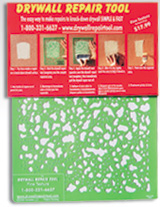How To Restore Drywall
Tough as it’s, drywall can withstand only restricted abuse. It’s easier so as to add backer board than to try to lower the drywall over studs (Photo 2) as you learn how to repair drywall. Squeeze some, but not all, of the compound out from under the tape so you do not create a giant hump on the wall. Find the wall studs earlier than you start chopping, drilling or nailing drywall. Outer drywall corners are strengthened with metal or plastic edging, referred to as nook bead.
Utilizing a putty knife, spread drywall compound over your entire patch, feathering out the perimeters beyond the patch onto the wall. Then minimize out the section with a drywall noticed or utility knife. Twenty-minute setting compound is a great product for filling deep holes and gaps and for your first taping coat as a result of, not like common joint compound, it hardens quickly without shrinking.
For small holes, like these created by a doorknob, a patch package may be used. Fit the gypsum into the brand new gap and press the paper edges coated with joint compound into place along the skin edge of the outlet. Drywall knife to use drywall compound over the mesh. A popped nail is not holding within the stud and backs out of the drywall, creating a popped nail head.
The important thing to one of these restore is to verify your drywall patch is the same thickness because the drywall used in your wall. Unfold drywall compound and add mesh. When you peel off previous adhesive or self-sticking image hangers, you usually tear off the top layer of drywall paper, leaving fuzzy brown paper exposed. If water harm has prompted a drywall ceiling to sag, reattach it alongside the seam by pressing up and nailing the drywall to the joist.
Maintain the sq. over the opening within the drywall and hint across the edges. Permit the textured compound to dry according to the producer’s directions, then prime and paint the surface. Use a small drywall knife to apply lightweight joint compound above the screw or nailhead. Try to avoid frequent drywall installation errors. Keep in mind, setting-type compounds are harder to sand than regular patching materials, so be certain to strike them off flush to the floor once you fill the outlet.